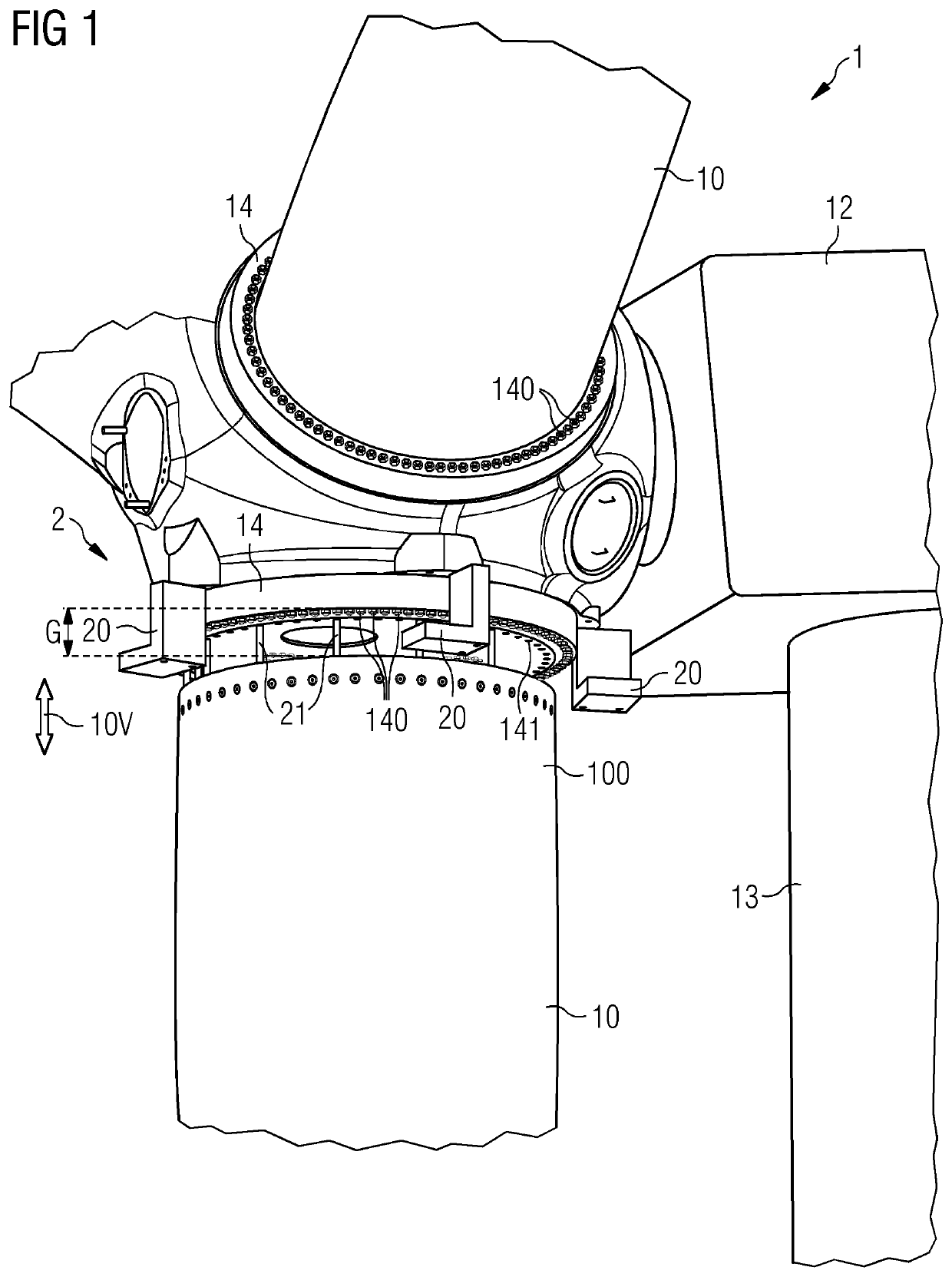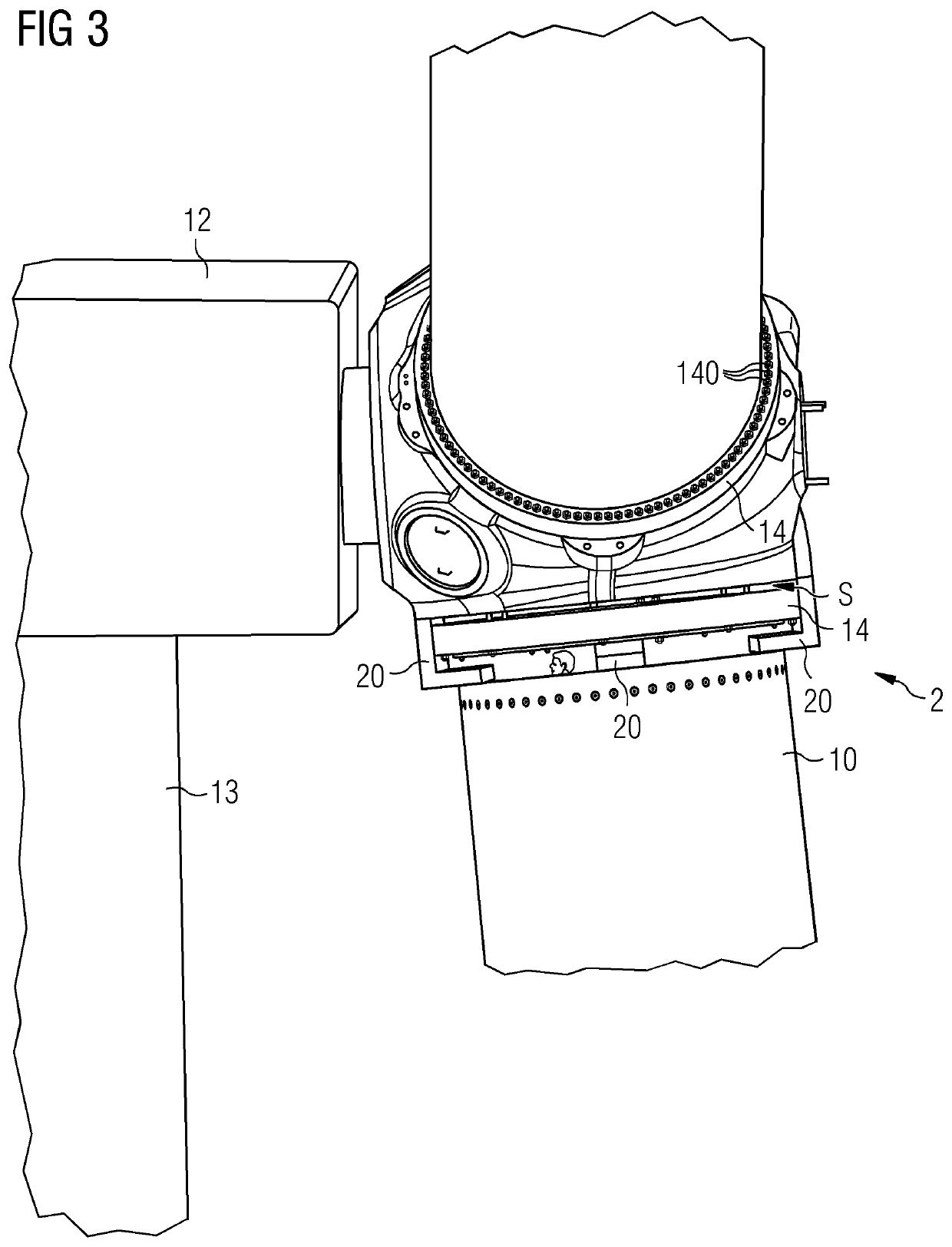Method of handling a wind turbine rotor blade pitch bearing unit
a technology of rotor blade and rotor blade, which is applied in the direction of machines/engines, mechanical equipment, and final product manufacturing, etc., can solve the problems of not being able to access the pitch bearing easily, requiring maintenance or replacement, and the type of pitch bearing is subject to wear and tear
- Summary
- Abstract
- Description
- Claims
- Application Information
AI Technical Summary
Benefits of technology
Problems solved by technology
Method used
Image
Examples
first embodiment
[0039]FIGS. 4-5 show further stages during the pitch bearing exchange procedure of FIGS. 1-3, using a bearing unit displacement assembly 22, 220. Here, a pivot 22 is permanently installed in the nacelle 12. For a bearing exchange procedure, a pivot arm 220 is mounted to the nacelle pivot 22. The pivot arm 220 can rotate about the nacelle pivot 22 in the direction 22R shown, and can enter the space S between bearing unit 14 and hub 11, so that a worker (inside the hub) can secure the bearing unit 14 to the pivot arm 22. Alternatively, the pivot arm 220 can enter the gap G between blade root end 100 and bearing unit 14, so that a worker inside the blade root end can secure the bearing unit 14 to the pivot arm 22.
second embodiment
[0040]In FIG. 5, a hoist unit 25, for example a small crane 25, is shown in place on top of the nacelle 12. This hoist unit 25 can be stowed in the nacelle 12 when not in use. A cable or chain can be secured to the bearing unit 14, for example by a maintenance worker inside the hub or blade root end. The hoist unit 25 can then lower the defective bearing unit 14 to ground level, where it is detached. If the pivot arm 220 was mounted to the bearing unit 14 from below, the entire pivot arm 220 may be detached from the nacelle pivot 22 and lowered to ground level along with the bearing unit 14. A replacement bearing unit 14′ can then be attached to the hoist unit 25 (and pivot arm 220, as the case my be) and raised to hub height, where the steps described above are performed in the reverse order to install the replacement bearing unit 14′ between hub 11 and rotor blade 10. After completion of the exchange manoeuvre, any temporary apparatus such as the extension rods, fixation brackets,...
third embodiment
[0041]FIG. 8 shows a further stage during the pitch bearing exchange procedure of FIGS. 1-3, using a bearing unit displacement assembly. Here, rail assemblies 24 are mounted between the bearing unit 14 and the hub 11, so that the bearing unit 14 can slide outwards, essentially horizontally in the direction 24H shown (a slight upwards tilt of the generator rotational axis may be assumed to exist to avoid tower / blade collisions). In this embodiment, a hoist unit 25 is temporarily mounted on top of the hub 11, so that it can be connected by cable or wire to the bearing unit 14 in order to lower the bearing unit 14 to ground level.
[0042]FIG. 9 shows the lowering of a bearing unit 14 to “ground level” during a pitch bearing exchange procedure, in this case to a marine vessel 90 near the tower of an offshore wind turbine. A defective bearing 14 at the interface 101 between blade 10 and hub 11 can be replaced with a minimum of cost and effort since a crane, large enough to reach to hub hei...
PUM
 Login to View More
Login to View More Abstract
Description
Claims
Application Information
 Login to View More
Login to View More - R&D
- Intellectual Property
- Life Sciences
- Materials
- Tech Scout
- Unparalleled Data Quality
- Higher Quality Content
- 60% Fewer Hallucinations
Browse by: Latest US Patents, China's latest patents, Technical Efficacy Thesaurus, Application Domain, Technology Topic, Popular Technical Reports.
© 2025 PatSnap. All rights reserved.Legal|Privacy policy|Modern Slavery Act Transparency Statement|Sitemap|About US| Contact US: help@patsnap.com



